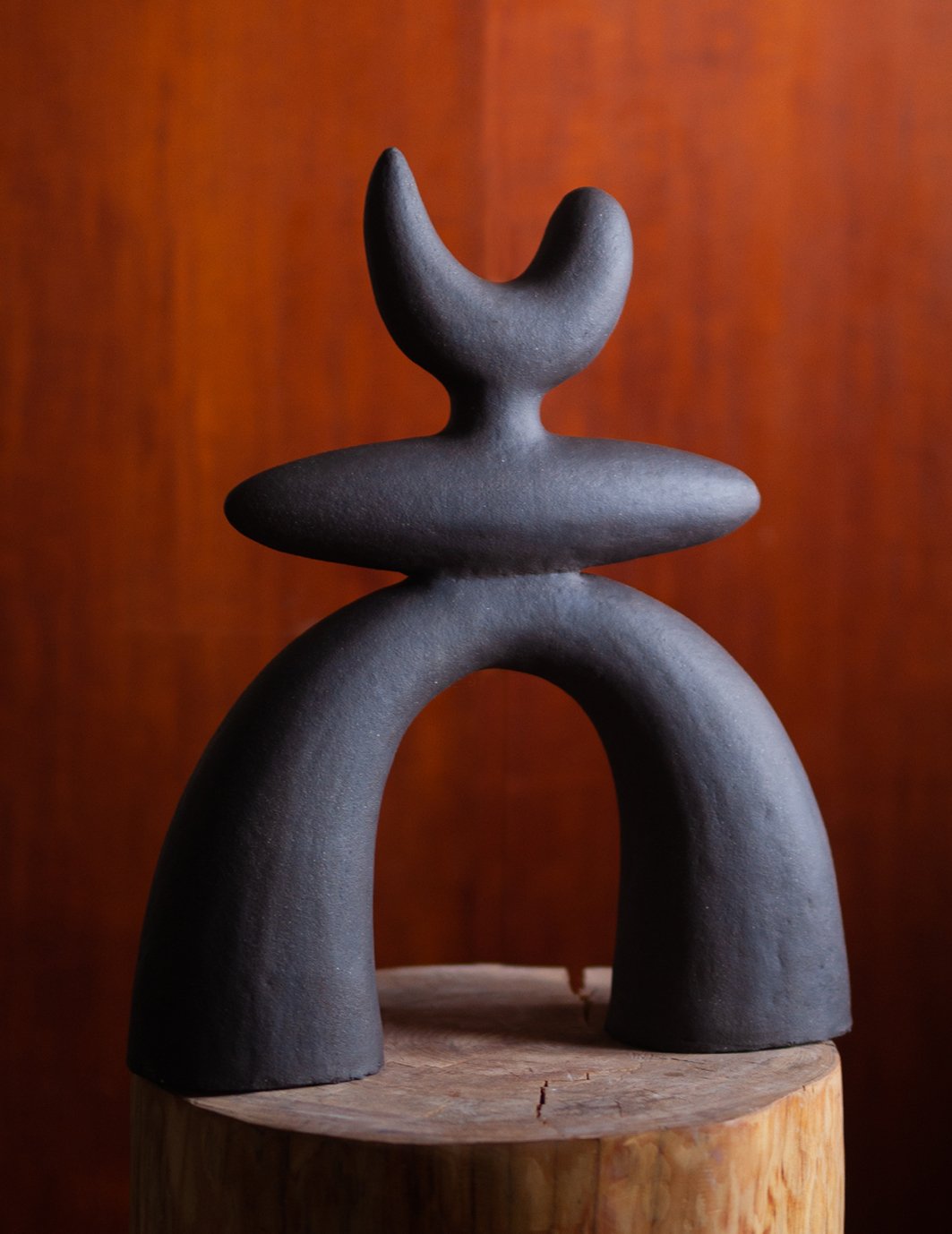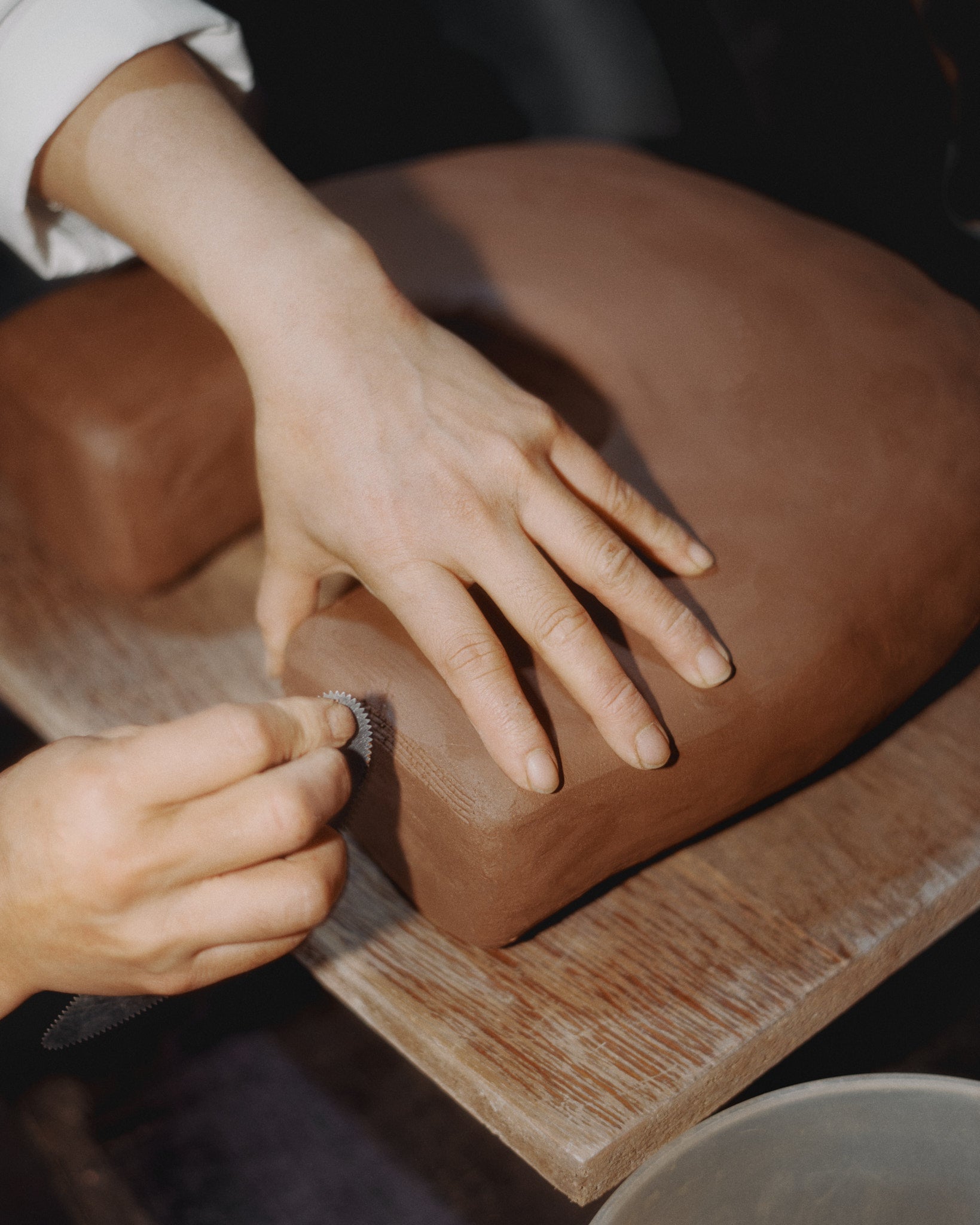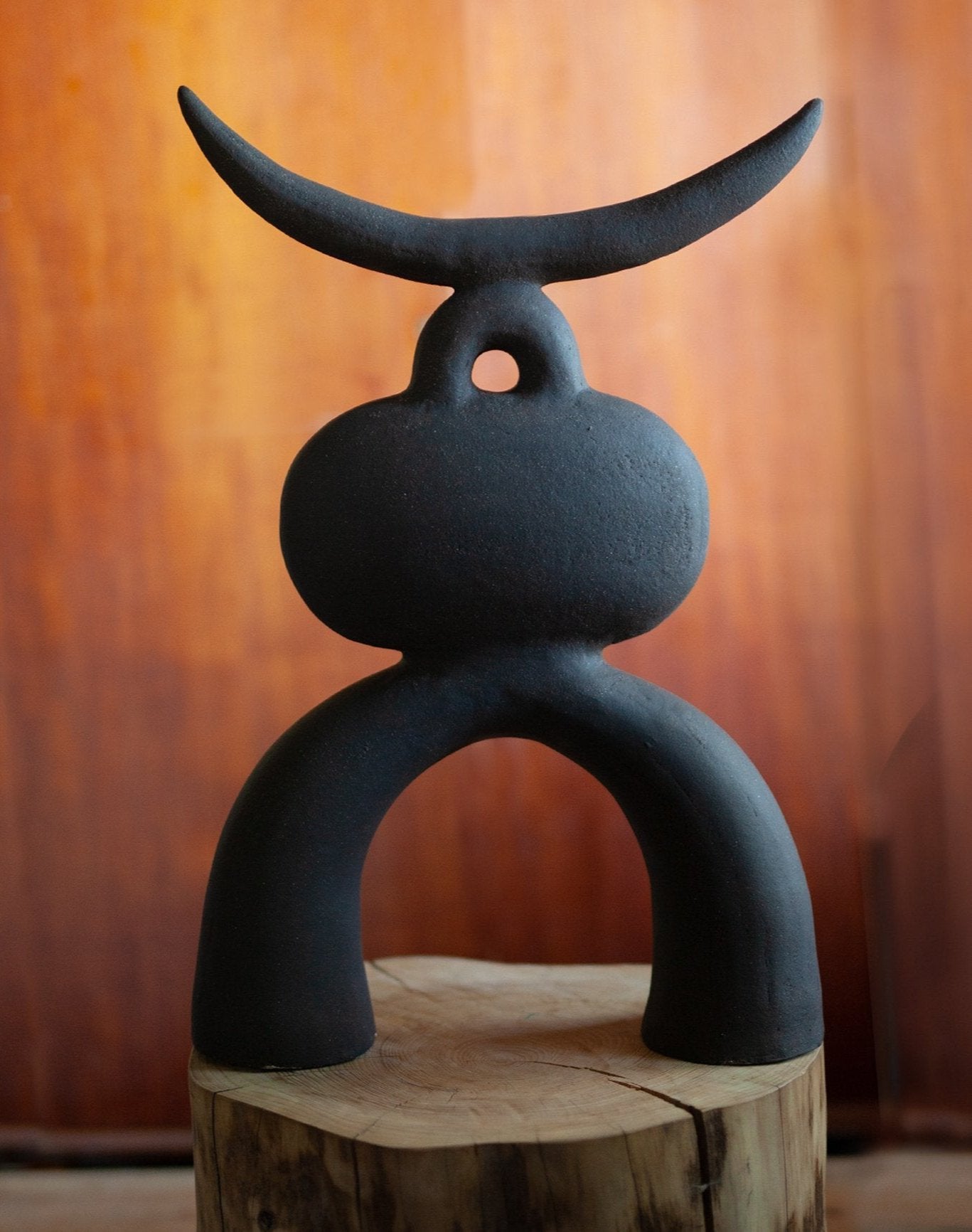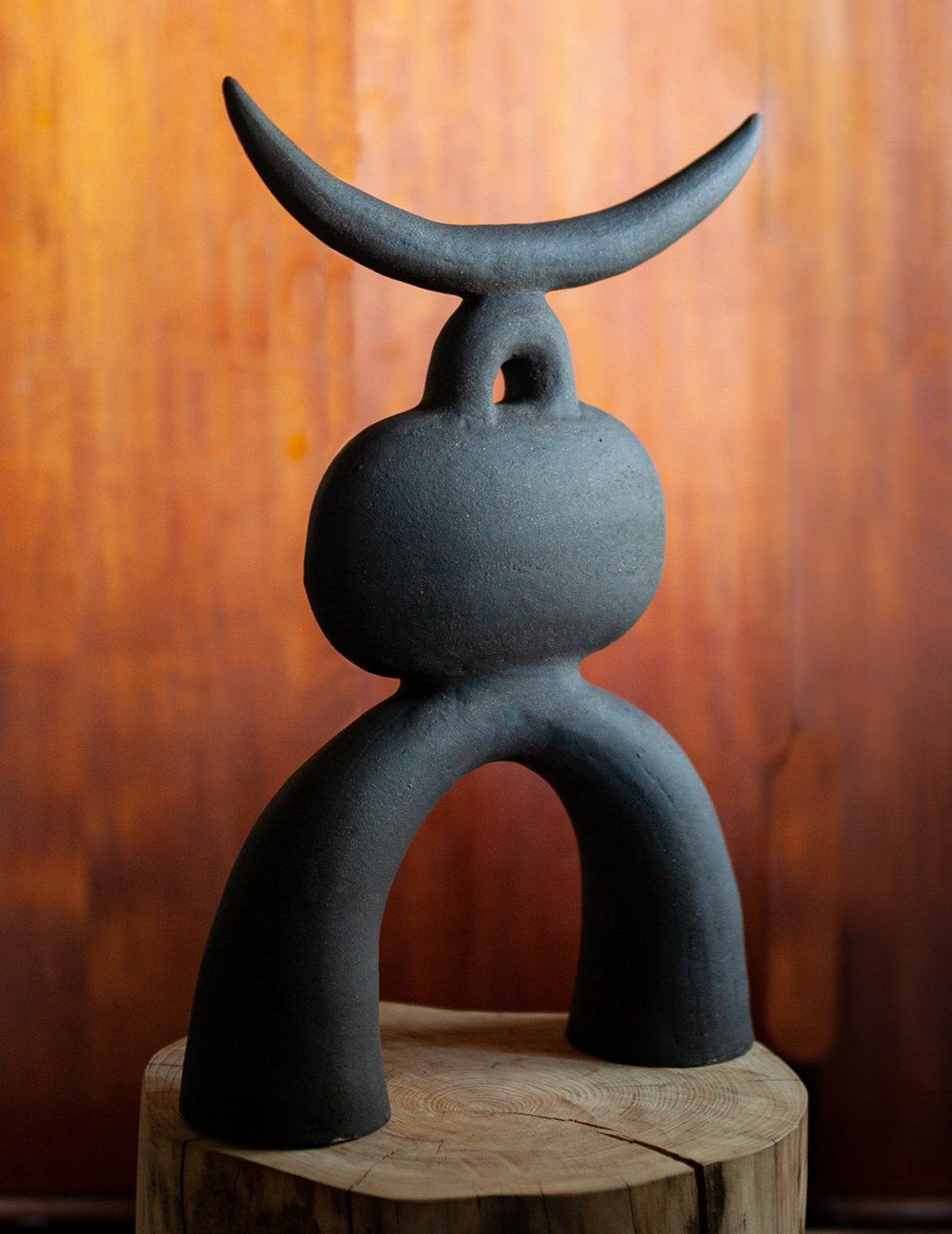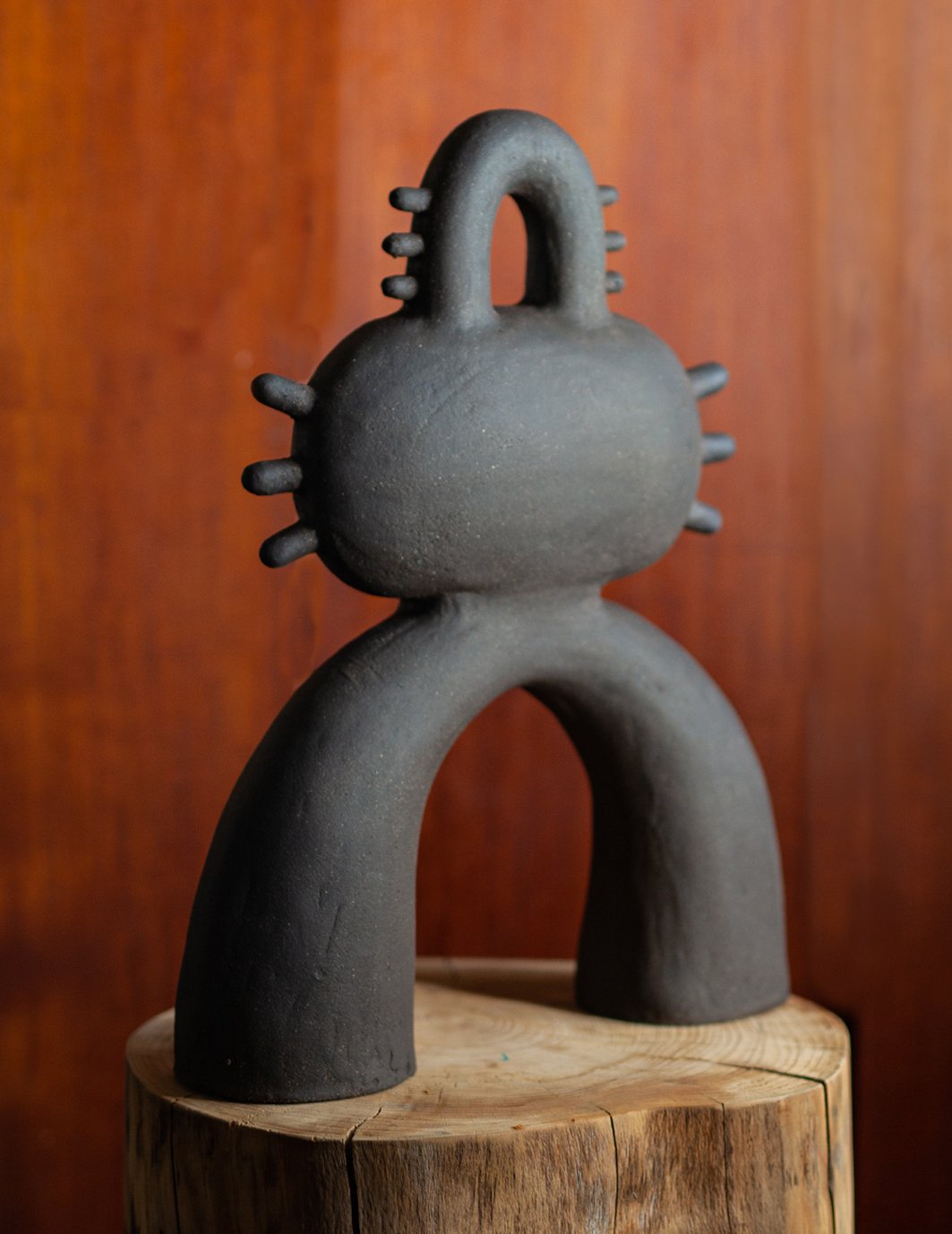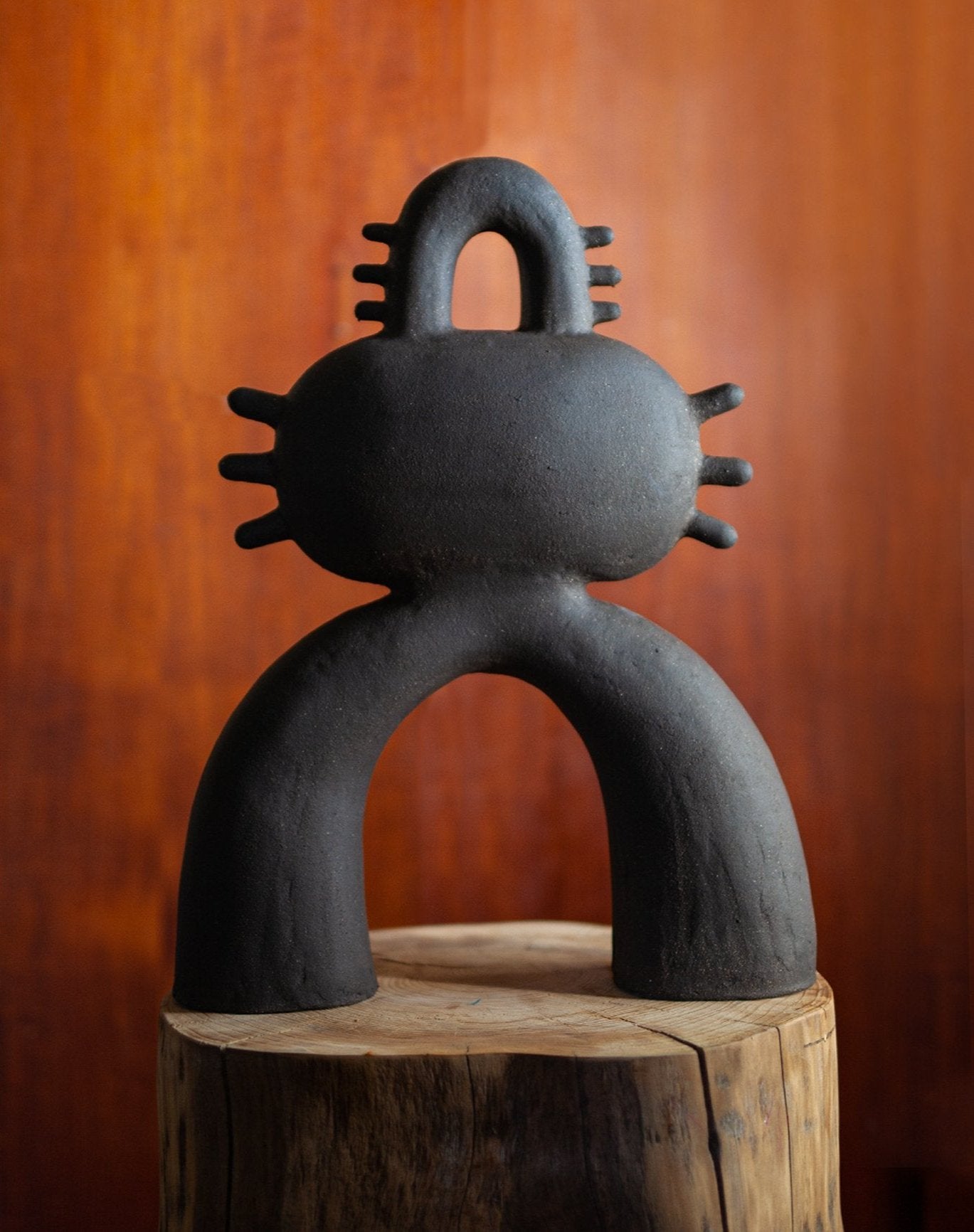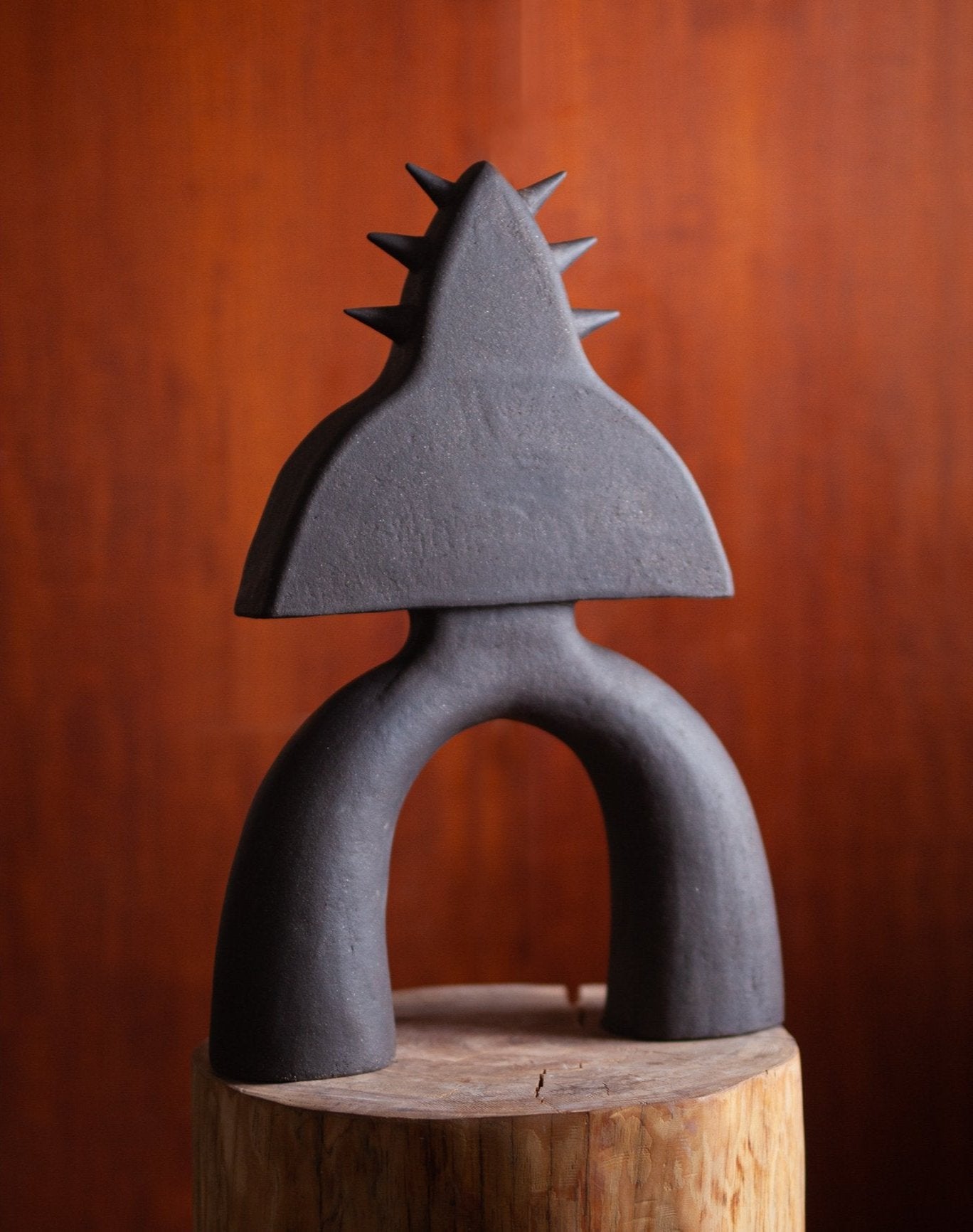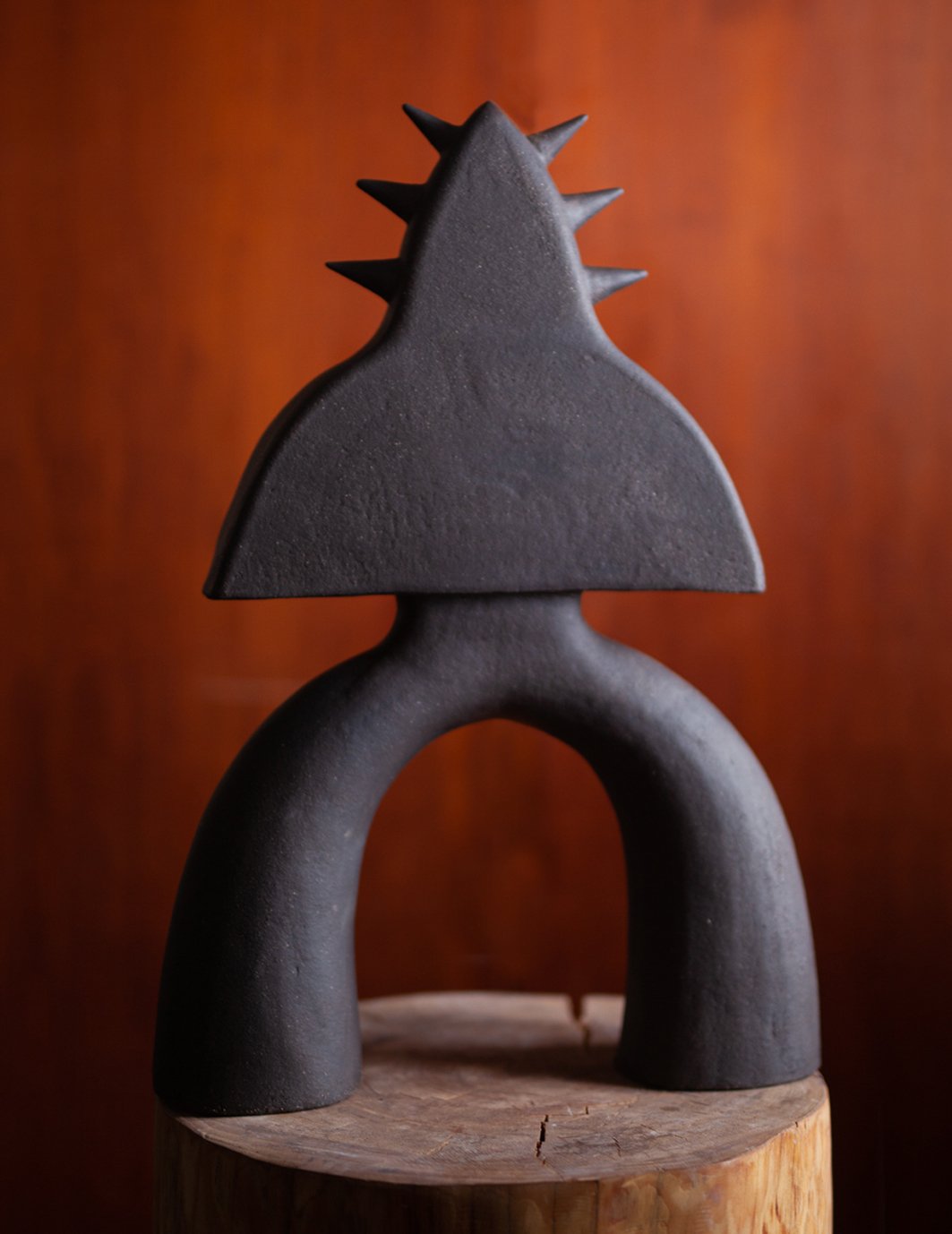The Weight of Beauty: Understanding Material Density
Pick up a handcrafted object and, before form or color, your hands register something elemental: weight. That instant impression—light and tender, or reassuringly solid—comes from material density. It’s the quiet physics behind presence, stability, and how an artwork converses with the room around it. At Trove Gallery, we invite you to feel that conversation in pieces by makers who understand weight as a design language: the earthen gravitas of Noe Kuremoto’s Haniwa Warriors, the serene poise of Ilona Golovina’s moon jars and Half Moon Jugs, and the airy-meets-grounded textures in Chala Toprak’s Ash Bloom series. This is a material story about density: how it’s made, how it’s felt, and how it helps you curate a home of lasting beauty.
Why Density Matters in Design
Density, simply put, is mass per unit volume—how much matter is packed into a given space. In the studio and in your home, density becomes a felt quality: the way a vessel settles on a console, how its base meets wood or marble, and how confidently a sculpture anchors a shelf. Higher-density materials often read as more substantial even at smaller scales, while lower-density pieces can feel delicate or airy without being fragile. For collectors, understanding density clarifies choices—especially for display, pairing, and long-term care.
In ceramics, density arises from the clay body, inclusions or grog, the level of vitrification, and the presence of glazes. A fired porcelain that’s highly vitrified can be remarkably dense and strong for its thickness, producing a clear bell-like ring when lightly tapped. Stoneware, typically fired at high temperatures, can achieve similar solidity with a more earthen texture and nuanced porosity. Earthenware, generally fired lower, can be slightly less dense and more porous, often chosen for warmth of color and tactile softness.
Designers think about density as a tool for balance: pairing a substantial centerpiece with lighter accents; mixing matte, absorptive surfaces with glossy, reflective ones; and ensuring harmony between mass and scale. For you, the collector, that means asking: How does this piece settle into my space? Does its weight support the narrative of the room? Does its density invite touch and presence without overwhelming the table, shelf, or plinth?
Clay Bodies and the Poetry of Weight
Ceramic density is a beautiful paradox. The more a piece is vitrified in the kiln, the more the clay’s particles fuse, reducing open pores and increasing strength. Yet, a highly vitrified piece can be formed quite thin—so the relationship between density and perceived weight isn’t linear. Two vessels of the same size might weigh differently because of wall thickness, foot design, and glaze composition. That complexity is where the poetry lives.
Consider porcelain and stoneware. Porcelain, refined and often translucent at the lip, can range around 2.3–2.5 g/cm³ when fired and fully matured, while dense stoneware may overlap in feel, from roughly 2.2–2.6 g/cm³ depending on the clay formula and firing. Those numbers are approximations; what you actually experience is the interplay of density, thickness, and profile. A thin porcelain moon jar can feel poised and surprisingly assertive—quietly heavy for its size—while a thicker stoneware jug may deliver a satisfying, grounded heft that anchors a vignette.
We see this dance of material and feeling in the work of Ilona Golovina, whose vessels echo traditional forms but breathe with contemporary clarity. Her White Tall Moon Jar ($1,920.00) holds space with serene verticality. The mass gathers in a rounded belly that settles gracefully on a narrow foot, giving the jar an elegant center of gravity. Step closer and you’ll sense the way its density supports the tall silhouette—steady, composed, and luminous. Its counterpart, Moon Jar 2 ($2,240.00), amplifies that presence with a softened fullness that catches light on the curve, reading almost like a moon’s halo at dusk.
For a more intimate scale, the Moon Jar Mini ($450.00) reveals how smaller objects can still feel substantial. Pick it up and you’ll notice a gentle heft that belies its compact size—an object lesson in how vitrification and profile give even petite pieces a reassuring stability on a nightstand, a bookshelf, or an altar-like mantel arrangement.
The Haniwa Warriors: Earthen Memory, Modern Mass
If porcelain carries a quiet, bell-clear weight, Noe Kuremoto’s Haniwa-inspired figures lean into the archetypal solidity of earth. Kuremoto channels an ancient sensibility—the clay guardians of the past—into contemporary forms that are intimate in scale yet resonant with presence. Density here is cultural and tactile: a weight of memory held in the clay, a physical anchor for stories that predate us and, with care, will outlast us.
Each Haniwa Warrior—hand-formed, with subtle variances in posture, gesture, and gaze—is a study in balance. The small footprint is deliberate, inviting display on a console or shelf where the figure’s mass feels compact but unwavering. The earthen body reads as dense and grounded; edges are softened, surfaces carry the touch of the maker. In your home, these become quiet companions: anchors that hold their own among books and vessels, plants and framed photographs.
Explore the series: Haniwa Warrior 93 ($1,700.00), Haniwa Warrior 85 ($1,700.00), Haniwa Warrior 74 ($1,700.00), Haniwa Warrior 92 ($1,700.00), Haniwa Warrior 124 ($1,700.00), Haniwa Warrior 107 ($1,700.00), and Haniwa Warrior 113 ($1,700.00). Display two or three together and notice how their cumulative density shapes a space: not heavy, but deeply grounded—like quiet punctuation on a sentence you want to linger over.
Pick one up and you’ll experience the maker’s choreography of mass: a base wide enough to steady, a torso that lifts without toppling, proportions tuned so density assists posture. It’s the physics of poise—felt, not calculated—with the clay’s compactness transmitting confidence right through the fingertips.
The Quiet Mass of Moon Jars and Half Moon Jugs
Ilona Golovina’s vessels speak a language of restraint. Where the Warriors root themselves, her jars and jugs breath in and out. That breath is dimensional: the curvature of the jar’s body, the line of a footring, the way a glaze moves across edges. Density becomes an ally of elegance—supporting tall forms, slim lips, and the ceremonial presence of a pot placed in a room.
The White Tall Moon Jar ($1,920.00) and Moon Jar 2 ($2,240.00) invite you to feel how a slightly higher mass at the lower hemisphere stabilizes the large, upper volume. Run your hand along the curve and you can almost sense how weight is distributed—like a tide held at perfect stillness. When you tap the body softly, the ring is clear and composed, a sign of dense, vitrified structure. The surface—whether luminous white or subtly tinted—carries light like a calm sky.
Contrast the jars with Golovina’s sculptural pourers, the Black Half Moon Jug ($1,740.00) and White Half Moon Jug ($1,740.00). Here the form is architectural: a crescent body that feels carved from a single moon-slice, an arcing handle that reads as line-drawing in space. The jugs’ density is perceptible in the palm—balanced to prevent forward pitching, weighted just enough for a steady pour if used, or a still, sculptural stance if purely displayed. Black or white, matte or satin, they frame negative space like a portal, each curve a quiet proof that substance and silhouette can be one and the same.
For the collector who loves to style shelves, try this: place a Moon Jar at eye level, a Half Moon Jug below it, and a small, low object—perhaps the Moon Jar Mini ($450.00)—beside the jug. The descending weights create a visual cadence, density stepping down across the composition so the eye lands where you want it to rest. You’ll feel the room relax around the arrangement.
Ash Bloom: Lightness in Look, Depth in Feel
Where the Moon Jars are serene and the Warriors are grounded, Chala Toprak’s work adds a lyrical texture—like wind on a field. Her Ash Bloom series captures that effect in surfaces that seem to float, even as the forms have satisfying body. The paradox is beautiful: to look airy and feel sure-handed.
Toprak’s Ash Bloom 02 ($1,430.00) and Ash Bloom 07 ($1,131.00) play with density at the tactile level. You sense it in the skin of the piece: a fine-grained, velvety touch that absorbs light rather than reflecting it, giving the work an atmospheric presence. The vessels feel steady on the hand—denser than their delicate visuals suggest—so you can place them on slender shelving or a console without fear of easy tipping.
In a mixed arrangement, Ash Bloom pieces operate as a soft counterpoint. Set Ash Bloom 02 near a Haniwa Warrior 92 and you’ll see a dialogue unfold: grounded figurative mass beside a vessel that hums with light. Add the White Half Moon Jug ($1,740.00) and the scene acquires a sense of gravity and lift—density choreographed across objects, each resonating at its own frequency.
Choosing for Balance: Placement, Surfaces, and Safety
Density is practical, too. A piece’s weight affects where and how you display it, and how you care for it over time. Consider these principles when curating:
Surface compatibility: Dense ceramics deserve stable, level surfaces. Wood, stone, and lacquered consoles are ideal; glass shelves can work with appropriate load ratings. If in doubt, check the furniture’s recommended weight capacity. Felt pads under bases protect both furniture and footrings, and they slightly decouple the piece from accidental vibrations.
Center of gravity: Tall forms like the White Tall Moon Jar ($1,920.00) are designed to be stable, but placing them away from edges and in areas of low foot traffic reduces risk. The Moon Jar Mini ($450.00) is a wonderful accent for narrow shelves precisely because its compact density allows it to sit snugly without feeling precarious.
Pairing heavy and light: Think of your space as a scale. A denser piece—say, Haniwa Warrior 124 ($1,700.00)—can balance a lighter, more open form like Ash Bloom 07 ($1,131.00). The human eye reads this balance instinctively; the arrangement feels complete without crowding.
Acoustics and touch: Lightly tap a vitrified vessel such as Moon Jar 2 ($2,240.00) and you’ll hear a clear ring, a sign of cohesive internal structure. Stoneware and earthenware may produce a warmer, shorter tone, communicating their own kind of strength. Always tap gently and with clean hands; the point is to listen to the material, not test its limits.
Care and cleaning: Dense, vitrified glazes are more resistant to staining, but all ceramics appreciate mindful care. Dust with a soft, dry cloth. If washing is necessary, use mild soap and hand-dry thoroughly before returning the piece to its place. For sculptures like Haniwa Warrior 107 ($1,700.00) and Haniwa Warrior 113 ($1,700.00), avoid abrasive materials that could alter the surface character.
Shipping and installation: Higher-density objects should be lifted by the body—not by handles or rims—to protect stress points. When moving the Black Half Moon Jug ($1,740.00), for instance, cradle the body and support the base. If you live in an area prone to vibration, museum putty can discreetly secure smaller works like Haniwa Warrior 74 ($1,700.00).
Beyond the Number: Density as Story
Numbers help, but density is ultimately about story—the story of earth transformed by fire and held in the hand. In Noe Kuremoto’s guardians—Haniwa Warrior 93, Haniwa Warrior 85, Haniwa Warrior 92, and their companions—you feel a weight of time and memory condensed in compact forms. In Ilona Golovina’s vessels—the tall white jar, the luminous Moon Jar 2, and the sculptural White Half Moon Jug—you meet density tamed into quiet poise. In Chala Toprak’s Ash Bloom 02 and Ash Bloom 07, density becomes texture and atmosphere, a way to hold the eye without weightiness.
These makers share a conviction: beauty should feel grounded—never fussy, never flimsy. Density is their ally in creating objects with presence. It helps a jug stand like a small architecture, a warrior rest like a sentinel, a moon jar glow with its own internal gravity. Bring them into your home, and you’ll find density doing the quiet work of harmony—balancing shelves and tables, steadying the gaze, setting a mood that endures.
We invite you to explore each maker’s world: discover Noe Kuremoto’s collection of Haniwa figures in our Noe Kuremoto collection, linger over the refined silhouettes in the Ilona Golovina collection, and let the soft atmospheres of the Chala Toprak collection guide your next arrangement. Together, these works compose a vocabulary of weight and lightness—a language you can curate room by room.
Make the Weight Yours
Choosing art is choosing how you want a space to feel. Invite in the grounded presence of a clay guardian, the serene mass of a moon jar, the hushed texture of an ash-bloomed surface. Start with one piece that speaks to you: perhaps the compact strength of Haniwa Warrior 93 ($1,700.00), the sculptural gesture of the Black Half Moon Jug ($1,740.00), or the intimate clarity of the Moon Jar Mini ($450.00). Then let density guide the rest—balancing what’s heavy and what’s light, what’s solid and what breathes.
At Trove Gallery, we champion the material intelligence of our makers—their sensitivity to clay and fire, proportion and presence. When you collect from them, you collect more than an object; you collect a feeling calibrated by hand and by heart. Explore the full edit today, and give your home the weight of beauty it deserves.
Ready to curate with intention? Shop the featured works now: Haniwa Warrior 93, Haniwa Warrior 85, Haniwa Warrior 74, Haniwa Warrior 92, Haniwa Warrior 124, Haniwa Warrior 107, Haniwa Warrior 113, Ash Bloom 02, Ash Bloom 07, White Tall Moon Jar, Moon Jar 2, Moon Jar Mini, Black Half Moon Jug, and White Half Moon Jug. Or explore by maker: Noe Kuremoto, Ilona Golovina, and Chala Toprak. Your next heirloom is waiting.
